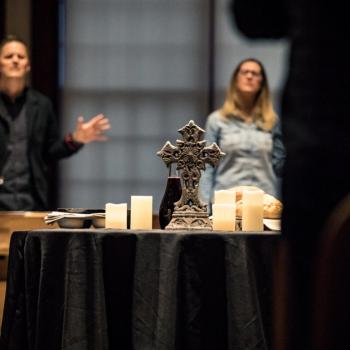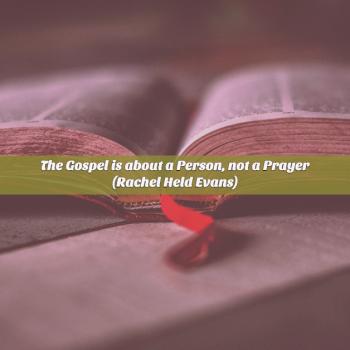I am excited to have a post here by David Ozab. He is a writer and recently converted to Roman Catholicism. While I do not share his denominational convictions, certainly it is beneficial to hear from others outside of our own sphere of experience. The body of Christ is multifaceted! I am pleased to have his guest contribution on the blog…
——————————————————————————————————
Part One: Prayer
In my last two posts, I wrote about my personal decision to join the Catholic Church and the important insight I gained from my wife—a lifelong Catholic and my sponsor. In this post, I want to describe a bridge that links my former communion (The Episcopal Church) to my current one. This is a bridge that links all Christians, a tradition we all share, and I believe it can serve as a gathering place until such time as Christ wills our full corporate reunion.
That gathering place is daily prayer.
One of the first things I did when I returned to The Episcopal Church—after years of nominal association—was to pick up a copy of the Book of Common Prayer and teach myself to pray Morning and Evening Prayer. Little did I know at the time that I was stepping into a rhythm of prayer that stretched back almost 1,500 years. A rhythm of prayer shaped by the Rule of Saint Benedict.
For though The Church of England under Henry VIII dissolved the monasteries and abbeys that once dotted the English countryside, the Benedictine spirit* survived in the Daily Offices first compiled by Archbishop Thomas Crammner, and lived on through various revisions of the Book of Common Prayer until monastic orders were revised during the Nineteenth Century Catholic Revival.
I didn’t know this at the time. I just wanted to practice the tradition I had been baptized into after many years of neglect. That meant Sunday Eucharist at church but it also meant daily prayer at home. Right away, I was drawn into the beauty of the language. I didn’t have to worry about finding the right words—the eloquent, poetic, and scripturally-based texts created a quiet, prayerful space in my heart. I have kept this space sacred for the last eleven years, praying most days and suffering on the days that I don’t.
Benedict discusses the Oratory (the place for prayer, from the Latin “Ora” to pray) in Chapter 52 of his Rule: “The Oratory must be simply a place of prayer . . . and it must not be used for any other activities at all.” In reading this passage, I realized that each of us needs to clear a space in our hearts for prayer. I call this the Oratory of the Heart: the place in each of us that is set aside solely for God.
The first step in establishing the Oratory of the Heart is to establish a daily habit of prayer. There are numerous resources that can assist in this practice, both in print and online, but the pattern laid out by all of them is the same:
1) The Invitatory: a short phrase that sets the mind in a prayerful space. Benedict uses two which I would recommend as openings for morning and evening prayer respectively:
“O Lord open my lips and my mouth shall proclaim your praise.” This line from Psalm 51 is ideal for morning, especially if you pray upon rising.
“O Lord make speed to save us. O God make haste to help us.” In the Rule, this line, which begins Psalm 70, opens all the offices said during the day, In a simpler practice it works well for evening prayer.
2) A psalm or psalms. The Psalter is the foundation of Benedictine prayer and in the Rule monks are instructed to pray through the whole of it each week. The is an impossible task for most, but to pray a psalm each day, or perhaps a cycle of popular psalms through the week, is a good starting point. This is where I began, but for the last few years I have followed Cramner’s schedule of praying the Psalter in order over the course of the month. This practice follows the spirit of Benedict in reading all the psalms within a fixed period of time while respecting the practical constraints of what I can manage in my day.
3) Scripture. Apart from the psalms, the Rule appoints readings from Scripture at each office. A daily lectionary or any “read the Bible in a year” plan is suitable. Most prayer books also provide short scripture readings.
4) A canticle. This is a song drawn from Scripture that is said (or traditionally sung) in response to the reading. The traditional Gospel canticles the Song of Zechariah (Luke 1:68-79) and the Song of Mary (Luke 1:46-55) are said at the morning and evening offices respectively. Many other canticles are included in prayer books. Here are a few examples from the 1979 BCP:
The Song of Moses (Exodus 15: 1-6, 11-13, 17-18)
The First Song of Isaiah (Isaiah 12: 2-6)
The Second Song of Isaiah (Isaiah 55 6-11)
The Third Song of Isaiah (60: 1-3, 11a, 14c, 18-19)
The Song of Simeon (Luke 2: 29-32)
A Song to the Lamb (Revelation 4:11; 5:9-10, 13)
The Song of the Redeemed (Revelation 15:3-4)
5) The Apostles Creed: the faith of our common baptism. If you don’t know this from your own church tradition, it’s found in most prayer books and is short and easy to learn.
6) The Lord’s Prayer: the common prayer of all Christians.
7) One or more prayers, petitions, thanksgivings, etc. These can be read from a prayer book or improvised if you prefer spontaneous prayer. Thanksgivings for the new day are appropriate for morning prayer, while repentance for sins committed during the day is appropriate for evening.
And that’s it. You could pray the offices with just a Bible and a few texts committed to memory, but it’s more practical to use a simple breviary or prayer book. Here are a few that I recommend checking out:
The Glenstal Book of Prayer
http://www.litpress.org/Detail.aspx?ISBN=0814627676The Benedictine Handbook
http://www.litpress.org/Detail.aspx?ISBN=0814627900Shorter Christian Prayer
http://www.catholicbookpublishing.com/ShowProduct.aspx?ProductID=288&DepartmentID=89&AspxAutoDetectCookieSupport=1The Book of Common Prayer
http://www.oup.com/us/catalog/general/subject/Bibles/PrayerBooks/1979BookofCommonPrayer/?view=usaBenedictine Daily Prayer
http://www.litpress.org/Detail.aspx?ISBN=0814628338A Celtic Primer
https://www.churchpublishing.org/products/index.cfm?fuseaction=productDetail&productID=1264Celtic Daily Prayer
http://www.northumbriacommunity.org/community-resources-and-shop?page=shop.product_details&flypage=flypage.pbv.tpl&product_id=4&category_id=5The Saint Helena Breviary
https://www.churchpublishing.org/products/index.cfm?fuseaction=productDetail&productID=430Common Prayer: A Liturgy for Ordinary Radicals
http://www.zondervan.com/Cultures/en-US/Product/ProductDetail.htm?ProdID=com.zondervan.9780310326199&QueryStringSite=Zondervan
There are also a large number of online daily office and breviary pages which you can find via Google, along with iPhone, iPad, and Android apps.
My personal favorite of these is St. Bede’s Breviary. Drawn from the Book of Common Prayer, it offers a flexible set of preferences that can accommodate both Protestant and Catholic spiritual practices.
Web Page: http://haligweorc.org/breviary/
Mobile version: http://www.haligweorc.org/breviary/mobile/
In my next post, I will talk about another practice important to the Oratory of the Heart: Lectio Divina—the prayerful reading of, and meditation upon, Scripture and spiritual reading. I am new to this practice, but I’ll be taking it up during Lent and will share my experience. Until then, may God grant you that good spirit which separates from death and leads to life**. Amen.
————————————————————-
*Robert Hale, O.S.B., “The Benedictine Spirit in Anglicanism.” Full Homely Divinity. http://fullhomelydivinity.org/articles/benedictinespirit.htm
**Paraphrased from Ch 72 of the Rule of Saint Benedict.











